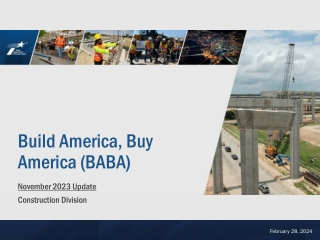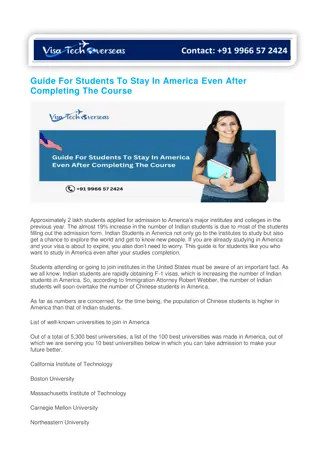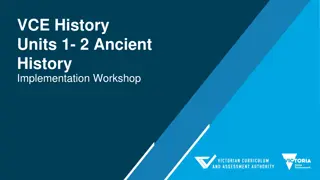The History of Racist Ideas in America
Explore the origins and impact of racist ideas in America, from Jefferson Davis' claims of Black inferiority to modern racial disparities in wealth, incarceration, and police violence. Segregationist and assimilationist viewpoints are examined, highlighting how racist ideas have perpetuated inequality. Discover how racism has been used to justify oppression throughout history, shaping the narrative of a nation built on principles of liberty and freedom.
Download Presentation

Please find below an Image/Link to download the presentation.
The content on the website is provided AS IS for your information and personal use only. It may not be sold, licensed, or shared on other websites without obtaining consent from the author. Download presentation by click this link. If you encounter any issues during the download, it is possible that the publisher has removed the file from their server.
E N D
Presentation Transcript
Stamped from the Beginning The Definitive History of Racist Ideas in America By IbramX. Kendi
Speech given to Congress in 1860 by Jefferson Davis, the Mississippi senator who later served as president of the Confederate States of America. From the floor of the Senate, Davis argued that the inferiority of black people was obvious and beyond question. Black inferiority, he claimed, had been stamped from the beginning , directly on to the bodily frames of Africans at the moment of creation.
Young black men 21 times more likely to be killed by police Black people 5 times more likely to incarcerated than white people Racial Disparities White households median wealth is 13 times that of black households 13.2% of US population is black, yet black people represent: 2.7% of nation s wealth 40% of the incarcerated population
Why do racial Disparities exist? - OR - Bad/unequal policies (antiracist) Bad/unequal people (racist) Racist ideas NORMALIZE inequality - People (not policies) are the problem
Segregationists Nature Black people are permanently or genetically inferior; black people are incapable of being civilized and developed; and their inferiorities are the cause of racial disparities. Two main groups of racist ideas Assimilationists - Nurture Black people are genetically equal, but became inferior due to their degrading environment, whether that environment is hot climates, poverty, or the history of oppression. Black people have the capacity to be civilized and developed one day. Both black inferiority and racial discrimination are the cause of racial disparities.
The Fairytale of Racism Ignorance and Hate Racist Ideas Racist policies
Racist ideas have always been a functional necessity to a Christian nation that was economically founded upon slavery while being politically and philosophically dedicated to the principles of liberty and freedom. Racist ideas historically developed to justify oppression Hardly any of their segregating, colonizing, enslaving and slave- trading predecessors thought they were racist. They proclaimed that they were speaking the truth, the truth of science, of nature, of logic, of religion. As Frederick Douglass noted: When men oppress their fellow men, the oppressor ever finds, in the character of the oppressed, full justification for his oppression.
The Fairytale of Racism Ignorance and Hate Racist Ideas Racist policies Fairytale of Antiracism: Many believe that racism will be defeated by showering racists with evidence disproving their fallacies: Uplift suasion Educational persuasion Upward mobility Even though, The only thing wrong with black people is that we think there is something wrong with black people The powerful have not and will not abolish racial discrimination as long as racism benefits them in some way
Cotton Mather 17th century Americas foremost minister and intellectual, preached that Africans were not cursed but instead sent to the Americas by God for the purpose of their enslavement. It was the responsibility of whites, according to Mather s divine mandate, to teach Africans the gospel and save their white souls from their black skin. Historical Guides Thomas Jefferson - wrote often of his disdain for the institution of slavery, but had no tolerance for the idea of black equality. He owned slaves and aggressively pursued the idea of re-settling, or colonizing, blacks in West Africa or the Caribbean. William Lloyd Garrison White abolitionist, supported gradual equality for blacks. Blamed black inferiority on the immoral institution of slavery, rather than divine curse or climate. Slavery had imbruted black Americans, leaving them ignorant, brutish and in need of assistance from their white defenders.
Historys Emancipator - Abraham Lincoln - Against the expansion of slavery because it prohibited free white people from finding homes and improving their lives by moving west. - I am not nor ever have been in favor of making black people voters or jurors, or politicians or marriage partners. There is a physical difference between the white and black races which I believe will forever forbid the two races living together on terms of social and political equality. And inasmuch as they cannot live, while they do remain together there must be the position of superior and inferior, and I as much as any other man am in favor of having the superior position assigned to the white race. - Emancipation of slaves during Civil War - My paramount object in this struggle is to save the Union, and is not either to save or destroy slavery. If I could save the Union without freeing any slave I would do it, and if I could save it by freeing all the slaves I would do that. What I do about slavery, and the colored race, I do because I believe it helps to save the Union.
Emancipation Proclamation January 1, 1863 - Lincoln described it as a fit and necessary war measure for suppressing said rebellion - Freed slaves in rebel states controlled by union (50,000) - Did not free slave in border-states (500,000) or formerly Confederate states (300,000) - Allowed slaves in confederate states to run away and join Union army
Scientific racism During the Age of Enlightenment (an era from the 1650s to the 1780s), concepts of monogenism and polygenism became popular. Monogenism contends that all races have a single origin, while polygenism is the idea that each race has a separate origin. Until the 18th century, the words "race" and "species" were interchangeable. Illustration from Types of Mankind (1854), whose authors Josiah Clark Nott and George Robins Gliddon implied that "Negroes" were a creational rank between "Greeks" and chimpanzees.
Thomas Jefferson (1743-1826) In his "Notes on the State of Virginia" Jefferson described black people as follows: They seem to require less sleep. A black, after hard labor through the day, will be induced by the slightest amusements to sit up till midnight, or later, though knowing he must be out with the first dawn of the morning. They are at least as brave, and more adventuresome. But this may perhaps proceed from a want of forethought, which prevents their seeing a danger till it be present. When present, they do not go through it with more coolness or steadiness than the whites. They are more ardent after their female: but love seems with them to be more an eager desire, than a tender delicate mixture of sentiment and sensation. Their griefs are transient. Those numberless afflictions, which render it doubtful whether heaven has given life to us in mercy or in wrath, are less felt, and sooner forgotten with them. In general, their existence appears to participate more of sensation than reflection... Comparing them by their faculties of memory, reason, and imagination, it appears to me, that in memory they are equal to the whites; in reason much inferior, as I think one [black] could scarcely be found capable of tracing and comprehending the investigations of Euclid; and that in imagination they are dull, tasteless, and anomalous... I advance it therefore as a suspicion only, that the blacks, whether originally a distinct race, or made distinct by time and circumstances, are inferior to the whites in the endowments both of body and mind. Benjamin Rush (1745 1813), a Founding Father of the United States and a physician, proposed that being black was a hereditary skin disease, which he called "negroidism", and that it could be cured. Rush believed non-whites were really white underneath but they were stricken with a non- contagious form of leprosy which darkened their skin color. Rush drew the conclusion that "whites should not tyrannize over [blacks], for their disease should entitle them to a double portion of humanity. However, by the same token, whites should not intermarry with them, for this would tend to infect posterity with the 'disorder'... attempts must be made to cure the disease". Samuel Stanhope Smith (1751 1819) was an American Presbyterian Minister and author of Essay on the Causes of Variety of Complexion and Figure in the Human Species in 1787. Smith claimed that Negro pigmentation was nothing more than a huge freckle that covered the whole body as a result of an oversupply of bile, which was caused by tropical climates.
Discussion Questions (groups of 3-4 people) 1. How have you been taught the history of racism? 2. How do we explain racism and slavery in America? 3. Does the definition of assimilationist racism impact the way you understand the history of racism in the US?

 undefined
undefined


























